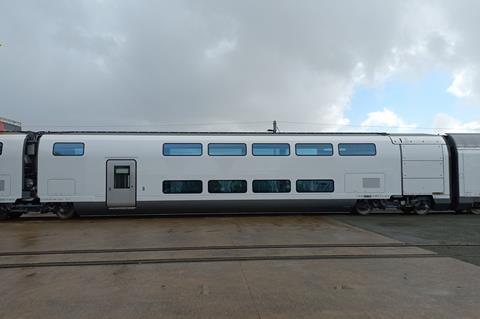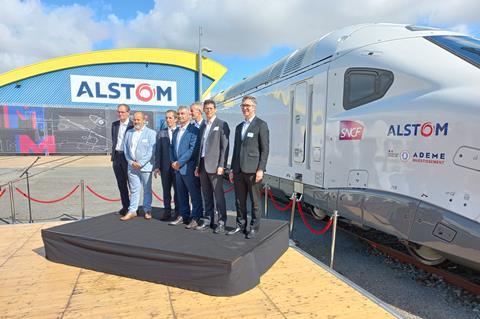
FRANCE: The first of 115 double-deck high speed trainsets branded Avelia Horizon by manufacturer Alstom and TGV M by SNCF Voyageurs has been unveiled ahead of dynamic testing at Velim in the Czech Republic from October.
Speaking at the unveiling at Alstom’s La Rochelle test centre on September 9, SNCF Voyageurs’ CEO Christophe Fanichet said TGM M was ‘a priority project’ to support of the national passenger operator’s goal of doubling ridership.
SNCF awarded Alstom a framework contract for up to 200 trainsets in July 2018 under its TGV du Futur programme. It has so far placed firm orders for 100 dual-voltage TGV M sets for domestic services and 15 four-voltage sets for international routes, with a total value of €3·5bn. Three trains have so far been built for pre-series testing.
Services

The first TGV M trainsets are expected to enter service on routes to the southeast of France at the end of 2024, but the fleet will eventually be deployed across the whole of the national high speed network.
Six of the 15 international sets are destined to replace the six TGV Réseau PLT sets used on the Paris – Lyon – Torino – Milano route from 2026-27, but plans for the deployment of remaining international trains are still being developed.
Design

Jean-Baptiste Eyméoud, CEO of Alstom France, said the company had spent €50m to adapt its factories to produce the new fleet, which involves 4 000 employees across 10 sites. Up to 12 sets will be delivered each year through to 2031.
As with the Alstom Avelia Liberty trainsets ordered by Amtrak in the USA, the TGV M features short power cars, providing space for an additional extra trailer car within the length of a standard trainset. However, the design is intended to offer greater flexibility than the current TGV fleet, with the ability to operate with seven, eight or nine coaches, to covert cars between first and second class and to reconfigure the interiors by removing or adding seats, bicycle or luggage spaces.
Alain Krakovitch, General Manager of SNCF TGV-Intercités said that the TGV M units would initially be formed as nine car sets 202 m long. He anticipated that the sets would not be reformed regularly, but said changes could be made overnight to match accommodation to demand at peak times such as annual holiday periods.
The TGV M sets will be deployed on both TGV Inoui and low-cost Ouigo services. Depending on the formation and seating configuration, the trains could offer a maximum capacity of 740 passengers, an increase of 20% on the current maximum of 634 passengers for a dedicated Ouigo Grande Vitesse trainset.
According to Alstom the TGV M interiors are designed to promote ‘rest and a muted atmosphere, for a serene and peaceful journey’, including lighting that adapts automatically to the intensity of the natural light.
TGV M is the first TGV which has been designed from the outset in close collaboration with groups representing people with reduced mobility. The aim is to offer fully independent access. A pivoting lifting platform will enable wheelchair users to access the train without assistance, and a sound system will guide visually impaired people to the doors.
The trains are expected to have 20% lower electricity consumption than a TGV Euroduplex.
The trains will be also highly connected, with 5G antennas on the roof and data connections supporting passenger wi-fi as well as providing data on onboard systems such as in doors, air-conditioning systems to support predictive maintenance.
Introduction

SNCF’s maintenance centres are being refurbished and adapted to handle TGV M trainsets, with the Technicentre Sud-Est-Européen to be the first base receiving the new units. The work includes installing automated inspection equipment that can check several hundred components of a train in a few seconds.
Krakovitch said the target was to cut maintenance costs by 30% compared to SNCF’s existing high speed fleet, with the Francilien commuter EMUs in Paris providing a model of what could be achieved.
Drivers were involved in the design of the cab, with virtual reality goggles used to assess three designs. Features include indirect lighting and controls positioned to facilitate easy use.
The new fleet will also mean changes to SNCF’s business processes. Alstom is developing an introduction programme for training staff, ‘so that they can be helped to make the new train their own.’

















